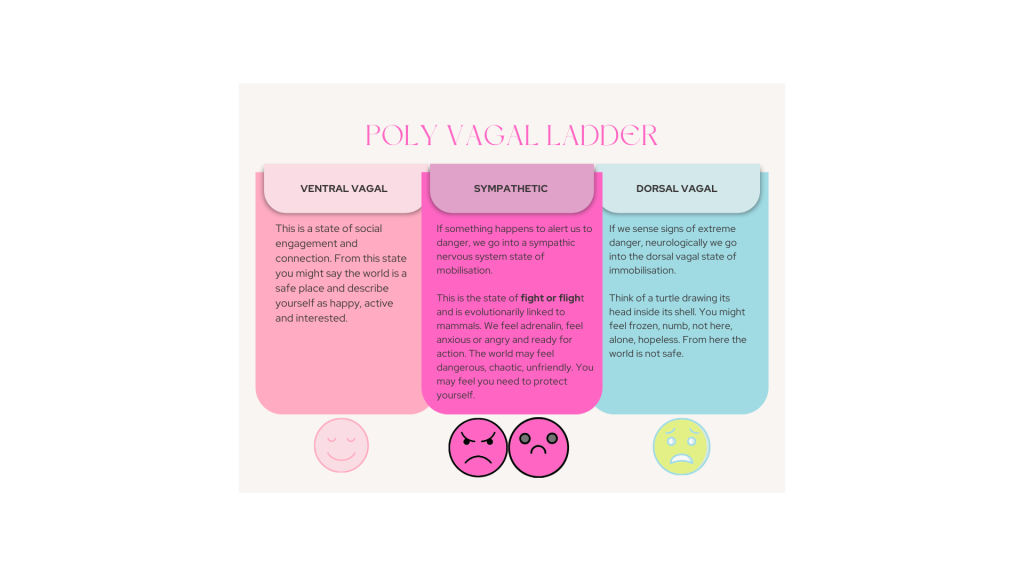Polyvagal theory shows that from the moment of birth our autonomic nervous system, without us thinking about it, is constantly scanning for signs of safety or danger this can be referred to as the Polyvagal ladder.
This scanning process is called neuroception.
Neuroception happens before perception. This means that it happens automatically prior to any conscious awareness.
The Ladder

A neuroception of safety brings us into a ventral vagal state, at the top of the “ladder”. This is a state of social engagement and connection. From this state you might say the world is a safe place and describe yourself as happy, active and interested.
If something happens to alert us to danger (e.g. you are driving and you hear police car sirens, your boss asks for a meeting in a stern tone), we go into a sympathic nervous system state of mobilisation. This is the state of fight or flight and is evolutionarily linked to mammals. We feel adrenalin, feel anxious or angry and ready for action. The world may feel dangerous, chaotic, unfriendly. You may feel you need to protect yourself.
Going down a step on the ladder, if we sense signs of extreme danger, neurologically we go into the dorsal vagal state of immobilisation. Think of a turtle drawing its head inside its shell. You might feel frozen, numb, not here, alone, hopeless. From here the world is not safe.
Shifting states
Throughout the day we shift through these states. We work our way up and down the ladder. Some of us live mostly in the ventral vagal zone, but others, often due to adverse life circumstances and trauma, tend to spend more time further down the ladder and have a harder time “climbing” up.
The more time we spend on different points on the ladder, the more we’re likely to get stuck in negative patterns. Porges even suggests we develop related physical symptoms.
Polyvagal-informed therapy offers tools to help you be closer to the top of the ladder, there many tools for mapping out your own nervous system ladder, including how you can help yourself climb up the ladder.
How knowing the Poly vagal Ladder help you?
Understanding your nervous system in this way can change the way you think of these states in yourself. Therefore there can be less self-judgement and more compassion for your state.
By recognising what state you are in a given moment, and understanding how you shift between states, you can change your state so you can feel connected and safer more of the time. You can feel less hopeless when you’re in the dorsal vagal shut down state, as you’ll know ways to help yourself out of it. You can also more easily enlist the help of others in this, since as mammals we need connection with others to feel safe.
This theory, is especially relevant for those with trauma in their background.
A trauma history often creates a hyper- or hypo-vigilant state, where either one is scanning for safety all of the time, and one can interpret neutral events or interactions as threatening ones, or one is shut down and depressed.
This is a natural result of trauma as our nervous systems have had to protect us against danger, and have now got used to that protection mode. The good news is that through positive connections (and possibly some therapy) we can help retrain the nervous system to be able to relax and feel safe.



